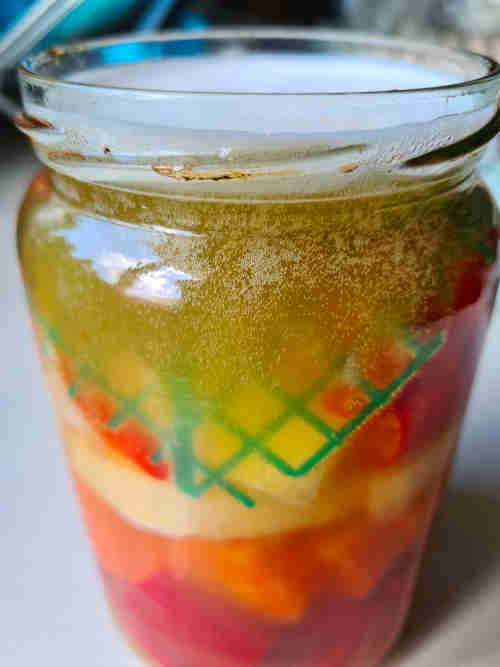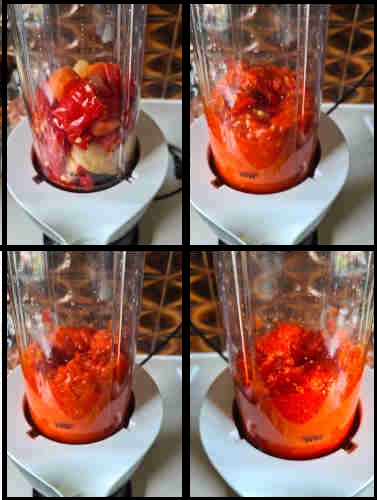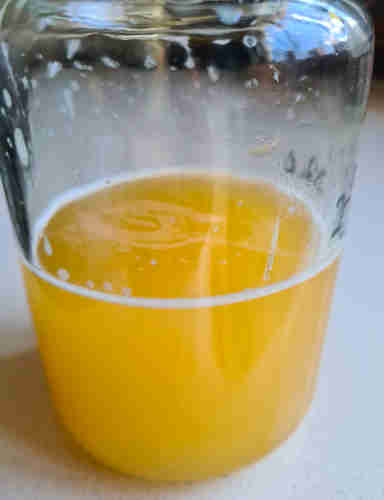The late summer and early autumn are the best time of the year to make this fermented hot sauce recipe. Hot peppers and fresh garlic are at their peak in late summer and early autumn. A nice hot summer will produce an incendiary hot pepper that leaves a lasting impression.

To get an amazing fermented hot sauce, fermentation is the secret ingredient. Hot sauce truly stands out with the help of lacto fermentation that gives the hot sauce a bright acidity and deep, complex flavor that develops slowly with time.
Most people do not know that the world’s most beloved hot sauces – from Tobacco to Sriracha were started with a fermentation process.
This fermented hot sauce recipe takes a bit of patience. A typical ferment can take from 2 weeks to a couple of months.
Types of peppers
There are many types of hot peppers that will give you a different level of heat in your hot sauce:
- Bhut Jolokia (also called Ghost Pepper): 1,001,304 SHU
- Scotch Bonnet: 100,000-580,000 SHU
- Habanero: 100,000-500,000 SHU
- Jamaican Hot: 100,000-200,000 SHU
- Chiltepin: 100,000 SHU
- Thai: 50,000-100,000 SHU
- Cayenne: 30,000-50,000 SHU
- Aji: 30,000-50,000 SHU
- Tabasco: 30,000-50,000 SHU
- Serrano: 8,000-23,000 SHU
- Mirasol: 5,000 SHU
- Jalapeño: 2,500-9,000 SHU
- Fresno: 2,500-8,500 SHU
- Hungarian Wax: 1,000-15,000
- Ancho: 1,000-2,000
- Poblano: 500-2,000 SHU
- Santa Fe: 500-700 SHU
- Anaheim: 250-1,400 SHU
- Pepperoncini: 100-500 SHU
- Paprika (several peppers are used for paprika) 50-200 SHU
- Pimento: 0 SHU
- Sweet Bell: 0 SHU
pH levels
When you make fermented hot sauce, that it is safe to be kept unrefrigerated for an extended period of time, you should watch the pH level. For home use, you should target levels of pH 4.0 and below.
There are several ways to measure the PH level. One cheap way is with the use of pH strips. A second way is to use a
A shelf-stable hot sauce can be created by getting the pH level low enough that bad bacteria cannot survive or that mold cannot grow by using acids that are created by the fermentation process.

Additions to the spicy sauce
To get a nice complex fermented hot sauce I like adding all types of roots, vegetables, spices, and even fruits:
Roots
| Garlic |
| Onion |
| Shallots |
| Carrots |
| Ginger |
| Turmeric |
| Horseradish |
| Beets |
Vegetables
| Celery |
| Green onion |
| Squash |
| Sweet Pepper |
Spices
| Allspice |
| Cinnamon |
| Cardamom |
| Cilantro |
| Turmeric |
| Red Pepper Flake |
| Cumin |
| Mustard Powder |
| Paprika |
| Smoked Paprika |
Fruits
| Cherry |
| Pumpkin |
| Mango |
| Pineapple |
| Blueberry |
| Pears |
| Papaya |
| Guava |
| Peach |
| Prunes |
At the end of the fermentation, I like blending all the ingredients and get my hot sauce done. To get a nice smooth texture I recommend using a good and strong blender. Using a food mill on a cooked sauce will give you an even smoother sauce with no seeds or pulp.

Xanthan gum
I’ve seen people who add xanthan gum to their hot sauce. It helps with shelf stability and making sure your sauce does not separate, it also helps add thickness and body to your sauces. I prefer to use only natural products and not to add xanthan gum.
Lacto Fermented hot sauce – recipe
To make this recipe you will need the following tools:
- Food digital weight
- Cutting board
- Sharp knife
- jar with top for fermentation
- Fermentation kit
Ingredients
- 10 Thai peppers (stems removed)
- (you can use Habanero and Jalapeño as well)
- 1 Carrot
- 3 Garlic cloves
- 1 Onion
- Water
- Salt
Instructions
1. Large chop all the ingredients
2. Transfer the chopped ingredients into a glass jar.
3. Place the jar (with the chopped ingredients inside) on the digital weight and reset the weight.
4. Add 5% kosher salt (5g of salt per 100g of water) to the jar.
5. Leave 3-5cm of space between the lip of jar and brine. Place a weighting stone on the top of the chopped peppers.
6. Close the jar tightly and set aside for 14-60 days. In the first three days, a pressure of 2CO is created inside and it is recommended to open and release the pressure twice a day.
7. Drain the peppers but reserve the brine.

8. Add the fermented peppers to a blender, along with 1/2 cup of the brine. If you are looking for a thicker hot sauce, only use 1/3 of, and do not strain the hot sauce. For a thinner hot sauce, add more 2/3 of the brine a bit at a time until you achieve the consistency you like. Straining the hot sauce will thin it out considerably.
9. Bottle the hot sauce and store it in the refrigerator in a sealed bottle. The most common sizes are 5 oz, 8 oz, and 10 oz woozy bottles.
This site is a participant in the Amazon Services LLC Associates Program and contains affiliate links to products. We may receive a commission for purchases made through these links.
